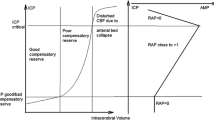Abstract
Objective: The study attempted to examine the relationship between neuropsychological functioning and reduced cerebral perfusion pressure (CPP), raised intracranial pressure (ICP), and reduced mean arterial pressure (MAP), monitored during intensive care treatment.
Design: This prospective follow-up study included consecutive patients and evaluated outcome at 6 months postinjury by the administration of a neuropsychological test battery.
Setting: The study was conducted at the University Hospital of Gent, Belgium.
Patients and participants: Over a 30-month period, 43 patients were included. Inclusion criteria were the following: hospital admission following closed head injury, ICP monitoring, no medical history of central nervous system disease or mental retardation, survival for at least 6 months, and informed consent for participation.
Interventions: All patients received the hospital’s standard treatment for head injury, which remained unchanged during the study period.
Measurements and results: Reduced CPP was analyzed using the number of observed values below 70 mmHg, raised ICP using the number of values above 20 mmHg, and MAP using the number of values below 80 mmHg. The neuropsychological test battery included 11 measures of attention, information processing, motor reaction time, memory, learning, visuoconstruction, verbal fluency, and mental flexibility. No linear relationships were found between overall neuropsychological impairment and episodes of reduced CPP, raised ICP, or reduced MAP.
Conclusions: Although reduced CPP and raised ICP are frequent, often fatal, complications of head injury, in survivors they do not seem to be related to later neuropsychological functioning.
Similar content being viewed by others
References
Rosner MJ,Coley I (1986) Cerebral perfusion pressure, intracranial pressure and head elevation. J Neurosurg 65: 636–641
Rosner MJ, Coley I (1987) Cerebral perfusion pressure: a hemodynamic mechanism of mannitol and the post-mannitol hemogram. Neurosurgery 21:147–156
Rosner MJ, Rosner SD, Johnson AH (1995) Cerebral perfusion pressure: management protocol and clinical results. J Neurosurg 83: 949–962
Miller JD, Becker DP, Ward JD et al (1977) Significance of intracranial hypertension in severe head injury. J Neurosurg 47:508–516
Marmarou A, Anderson RL, Ward JD et al (1991) Impact of ICP instability and hypotension on outcome in patients with severe head trauma. J Neurosurg 75 [Suppl]: S159-S166
Marmarou A, Anderson RL, Ward JD et al (1991) NINDS Traumatic Coma Data Bank: intracranial pressure monitoring methodology. J Neurosurg 75: 21–27
Fearnside MR, Cook RJ, McDougall P, McNeil RJ (1993) The Westmead Head Injury Project outcome in severe head injury: a comparative analysis of pre-hospital, clinical and CT variables. Br J Neurosurg 7: 67–279
Changaris DG, McGraw CP, Richardson JD, Garretson HD, Arpin EJ, Shields CB (1987) Correlation of cerebral perfusion pressure and Glasgow Coma Scale to outcome. J Trauma 34: 1007–1013
Jones PA, Andrews PJD, Midgley S et al (1994) Measuring the burden of secondary insults in head injured patients during intensive care. J Neurosurg Anesth 6: 4–14
Cortbus F, Jones PA, Miller JD, Piper IR, Tocher JL (1994) Cause, distribution and significance of episodes of reduced cerebral perfusion pressure following head injury. Acta Neurochir 130:117–124
Marmarou A (1992) Increased intracranial pressure in head injury and influence of blood volume. J Neurotrauma 9: S327-S332
Kawahara N, Sasaki M, Mii K et al (1989) Sequential changes of auditory brain stem responses in relation to intracranial and cerebral perfusion pressure and initiation of secondary brain stem damage. Acta Neurochir 100: 142–149
Chan K, Miller JD, Piper IR (1992) Cerebral blood flow and constant cerebral perfusion pressure but changing arterial and ICP: relationship to autoregulation. J Neurosurg Anesth 4:188–193
Anggard E (1994) Nitric oxide: mediator, murderer and medicine. Lancet 343:1199–1206
Jennett B, Bond M (1975) Assessment of outcome after severe brain damage. Lancet I: 480–484
Uzzel BP, Obrist WD, Dolinskas CA, Langfitt TW (1986) Relationship of acute CBF and ICP findings to neuropsychological outcome in severe head injury. J Neurosurg 65: 630–635
Levin HS, Eisenberg HM, Gary HE et al (1991) Intracranial hypertension in relation to memory functioning during the first year after severe head injury. Neurosurgery 28:196–200
Levin HS, Gary HE, Eisenberg HM et al (1990) Traumatic Coma Data Bank Research Group: neurobehavioral outcome one year after severe head injury: experience of the Traumatic Coma Data Bank. J Neurosurg 73: 699–709
Lezak MD (1995) Neuropsychological assessment, 3rd edn. Oxford University Press, New York
Spreen O, Strauss E (1991) A compendium of neuropsychological tests. Oxford University Press, New York
Fepsy (1995) The iron psyche. Normative data, vol 2 and 3. Nederlands Instituut voor Epilepsiebestrijding, Heemstede
Heaton RK, Chelune GJ, Talley JL et al (1993) Wisconsin Card Sorting Test. Manual-revised and expanded. Psychological Assessment Resources, Odessa
Lannoo E, Vingerhoets G (1997) Flemish normative data on common neuropsychological tests: influence of age, education, and gender. Psychol Belg 37:141–155
Dikmen S, Machamer JE (1995) Neurobehavioral outcomes and their determinants. J Head Trauma Rehabil 10: 74–86
Author information
Authors and Affiliations
Corresponding author
Rights and permissions
About this article
Cite this article
Lannoo, E., Colardyn, F., De Deyne, C. et al. Cerebral perfusion pressure and intracranial pressure in relation to neuropsychological outcome. Intensive Care Med 24, 236–241 (1998). https://doi.org/10.1007/s001340050556
Received:
Accepted:
Published:
Issue Date:
DOI: https://doi.org/10.1007/s001340050556




